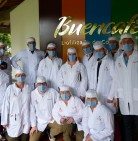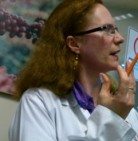 The day started very early with take off at 06.00.
The day started very early with take off at 06.00.
Destination: Pereira and Cenicafé (Centro de Investigación de Cafe).
Doctor Gloria Inez Puertas told us about the work of CENICAFÉ and about the Buenas Practicas Agricolas, a project formed by the government and FNC to improve quality and environmental care at farm level.
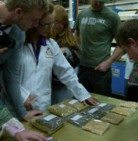 Gloria showed different samples of green and parchment coffee defects.
Gloria showed different samples of green and parchment coffee defects.
From left Emil, Gloria, Camille, Mikel and Sebastian peeping in.
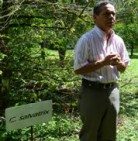 After that we met Hernando Cortina Guerrero, a scientist with biotechnology and genetics of the coffee plant as his field.
After that we met Hernando Cortina Guerrero, a scientist with biotechnology and genetics of the coffee plant as his field.
He showed us around the CENICAFÉ plantation where they had several known and unknown species and varieties.
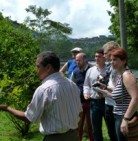 Hernando took us around the plantation and told us all he knew about plant chromosomes, generics, species and varieties.
Hernando took us around the plantation and told us all he knew about plant chromosomes, generics, species and varieties.
We all walked out of there confused on a higher level… ready to ask more questions.
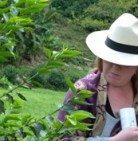 Camilla from Kaffebrenneriet is on her first trip to origin
Camilla from Kaffebrenneriet is on her first trip to origin
– and already looking like a Colombian.
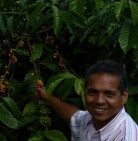 Hernando proudly showing his big Robusta plant teaching us about the differencies from the Arabica plant.
Hernando proudly showing his big Robusta plant teaching us about the differencies from the Arabica plant.
For one the leaves are not flat, but create (kind of) a canal form and are rougher in the texture. And off course the beans are rounder instead of oval.
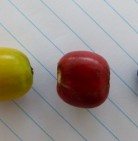 The size of the beans varies a lot.
The size of the beans varies a lot.
This photo shows (from left) a Yellow Maragoype, a (red) hybrid between Caturra and Canephora (robusta) and a (black) Liberica bean.
Next on the program was to visit the BuenCafé, a factory producing freeze dried coffee (instant coffee).
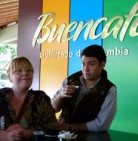 Camilla and Camillo enjoying a cup of instant BuenCafe before the tour.
Camilla and Camillo enjoying a cup of instant BuenCafe before the tour.
Unfortunately we were not allowed to photograph during the tour.
There for no photos from the factory!
To freeze dry coffee is a long process of roasting and then extracting the coffee with pressurised water (180 degrees celcius) for 6 x 90 minutes (!).
Then they add air to this veryveryvery strong coffee and thereby make it into a foam. The foam gets frozen at -50 degrees celcius and ground before they freeze drying begins.
Under vacuum pressure and low temperatures (- 50 degrees Celcius) the remaining water in the coffee vaporises. And voilá – you have the finest Colombian instant coffee.
Below the NBC crew ready for the trip of the factory! See if you can recognize us…
